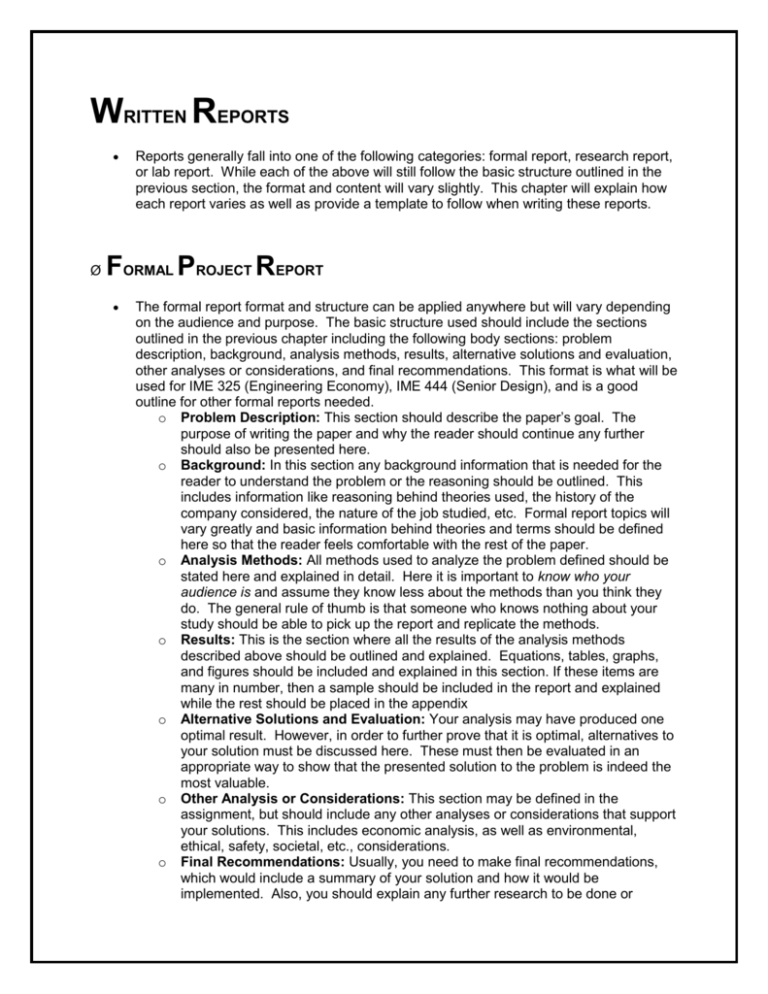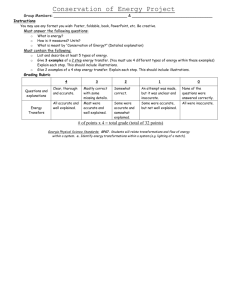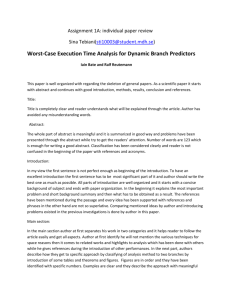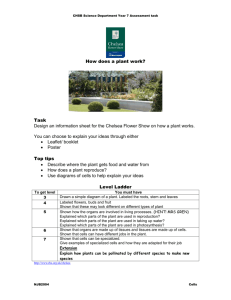Written Reports - Montana State University
advertisement

WRITTEN REPORTS Ø Reports generally fall into one of the following categories: formal report, research report, or lab report. While each of the above will still follow the basic structure outlined in the previous section, the format and content will vary slightly. This chapter will explain how each report varies as well as provide a template to follow when writing these reports. FORMAL PROJECT REPORT The formal report format and structure can be applied anywhere but will vary depending on the audience and purpose. The basic structure used should include the sections outlined in the previous chapter including the following body sections: problem description, background, analysis methods, results, alternative solutions and evaluation, other analyses or considerations, and final recommendations. This format is what will be used for IME 325 (Engineering Economy), IME 444 (Senior Design), and is a good outline for other formal reports needed. o Problem Description: This section should describe the paper’s goal. The purpose of writing the paper and why the reader should continue any further should also be presented here. o Background: In this section any background information that is needed for the reader to understand the problem or the reasoning should be outlined. This includes information like reasoning behind theories used, the history of the company considered, the nature of the job studied, etc. Formal report topics will vary greatly and basic information behind theories and terms should be defined here so that the reader feels comfortable with the rest of the paper. o Analysis Methods: All methods used to analyze the problem defined should be stated here and explained in detail. Here it is important to know who your audience is and assume they know less about the methods than you think they do. The general rule of thumb is that someone who knows nothing about your study should be able to pick up the report and replicate the methods. o Results: This is the section where all the results of the analysis methods described above should be outlined and explained. Equations, tables, graphs, and figures should be included and explained in this section. If these items are many in number, then a sample should be included in the report and explained while the rest should be placed in the appendix o Alternative Solutions and Evaluation: Your analysis may have produced one optimal result. However, in order to further prove that it is optimal, alternatives to your solution must be discussed here. These must then be evaluated in an appropriate way to show that the presented solution to the problem is indeed the most valuable. o Other Analysis or Considerations: This section may be defined in the assignment, but should include any other analyses or considerations that support your solutions. This includes economic analysis, as well as environmental, ethical, safety, societal, etc., considerations. o Final Recommendations: Usually, you need to make final recommendations, which would include a summary of your solution and how it would be implemented. Also, you should explain any further research to be done or considerations that should be made before final decisions are made. Whatever information that is pertinent to the topic that will help bring all the ideas together should be included here. Ø Ø RESEARCH REPORT A research report format should be used in situations where research is the primary source of information. This research is used to support some argument that the author is presenting to the reader. Again formality may vary. This format is what will be used in IME 490 (Undergraduate Research), IME 413 (Human Factors and Ergonomics), as well as other opportunities where research is conducted. The research report should follow the basic structure outlined in the previous chapter. It is the body that will be defined here. It should include objective, methods, results, and discussion sections. o Objective: Following the introduction, an objective statement section should stand alone to clearly define the purpose of the research. The argument as well as thesis of the paper should be stated here in a concise way to prepare the reader for what is intended to be proven. o Methods: Here a complete description of the methods of research conducted should be outlined. A section on the source of the data for the research should be explained to further support any analysis conducted. The different methods of analysis should also be properly documented and explained to the reader. Remember your audience here: not everyone is familiar with all engineering methods, not even engineers, and the author should be aware of this. o Results: This is the section where all the results of the analysis methods described above should be outlined and explained. Equations, tables, graphs, and figures should be included and explained in this section. If these items are many in number, then a sample should be included in the report and explained while the rest should be placed in the appendix o Discussion: This section should include all implications of the results. The results should be analyzed and the writer should explain about how the results support the objective argument stated. Also any recommendations that can be made for further research can be stated in this section. LAB REPORT The lab report will be used in any situation/class where a lab period is required. This includes all the basic science classes (chemistry, physics, etc.) as well as engineering classes (IE labs, EE labs, etc.). These reports will most likely be written more than once throughout the course. This means that having a standard format for the report will reduce time spent on the writing process. Different instructors will require different levels of formality, so make sure that is understood when writing the report. For example, not every report will require a title page, table of contents, and/or summary. When in doubt follow the most formal structure. Being as this report will follow the basic structure outlined in the previous chapter the specifications to the body sections of the report are the ones to be outlined. The body of a lab report should include materials, methods, and assumptions used, experimental procedure, results, and discussion sections. o o o o Materials, Methods, and Assumptions: Depending on formality and requirements of the assignment, this section could simply be a list of materials or equipment used. The list should be comprehensive and descriptive. For more formal reports, the materials, methods and/or assumptions used throughout the report should be explained so that the rest of the report makes sense to the reader. Experimental Procedure: This section should explain exactly what procedures were conducted in chronological order. This should be explained exactly how it was completed, not how the experiment was supposed to be completed. From this section the reader should be able to duplicate the experiment if need be. Results: Here all calculations, tables, graphs, and results from the procedure stated above should be outlined and explained in detail. If these items are many replications in number, then a sample should be included in the report and explained while the rest should be placed in the appendix. Discussion: In this section the implications or what was understood from the results is discussed. Here the results can be analyzed as well as interpreted by the author. Also anything pertaining to the experiment that could be considered an error should be discussed here. For further reading or more information on the above information, please see the following websites: o Formal Reports: www.une.edu.au/tlc/aso/students/factsheets/formal-report.pdf o Research Reports: http://www.ruf.rice.edu/~bioslabs/tools/report/reportform.html o Lab Reports: http://www.rpi.edu/web/writingcenter/labs.html http://www.writing.eng.vt.edu/workbooks/laboratory.html The next pages provide a template for writing reports with proper format. Note that this is just an outline and can be modified as needed to meet the needs of the report. Comments are made to walk you through each section of the template in italics and should not be included in a final draft. Refer to Appendix A of this toolkit for some sample grading rubrics provided by your professors for written reports, seen on page 40. These rubrics should be used to know what different professors are expecting and what areas to focus on in the written report.




